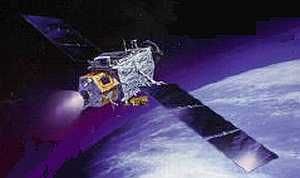
Home - Search - Browse - Alphabetic Index: 0- 1- 2- 3- 4- 5- 6- 7- 8- 9
A- B- C- D- E- F- G- H- I- J- K- L- M- N- O- P- Q- R- S- T- U- V- W- X- Y- Z
ARGOS
 Argos |
AKA: P91-1. Status: Operational 1999. First Launch: 1999-02-23. Last Launch: 1999-02-23. Number: 1 . Thrust: 2.00 N (0.40 lbf). Gross mass: 2,720 kg (5,990 lb). Specific impulse: 800 s.
It carried an electric propulsion experiment, ionospheric instruments, a space dust experiment, and the NRL's USA hard X-ray astronomy detectors for X-ray binary star timing observations. ARGOS was built by Boeing/Seal Beach.
The ARGOS satellite was built by Space & Missile system Center (SMC), Los Angeles AFB, CA under the program P-91-1. ARGOS carried nine DoD space experiments to orbit, most notably the ESEX Arcjet thruster.
The ESEX (Electric Propulsion Space Experiment) program began in 1989 under the then Air Force Astronautics Lab, Edwards AFB, CA. The prime contractor was TRW, Space Park, Redondo Beach, CA. The Arcjet was build by Rocket Research (now Aerojet), Redmond, WA. The ESEX experiment flew once in 1999 on board the ARGOS satellite.
ESEX was the first High Power Electric Propulsion flight. The system operated on 30 kW with about 26 kW to the thruster. The experiment was powered by 205 kg of silver zinc batteries built by Eagle Pitcher Company of Joplin, Mo. At the time this was the highest power subsystem ever flown in space.
The objective was to verify Arcjet performance in space and determine if any spacecraft compatibility or contamination issues existed. AGROS operated with no detectable impact when the thruster operating. Sensors detected no RF interference, no increase in contamination, and measurements of specific impulse and thrust were within ground measurement uncertainty.
This truly pioneering flight program gave the satellite community great confidence in using High Power Electric propulsion.
More at: ARGOS.
Family: Ion engine technology satellite, Sun synchronous orbit, Technology. Country: USA. Engines: ESEX Arcjet. Launch Vehicles: Thor, Delta, Delta 2 7000, Delta 7920-10. Propellants: Electric/Ammonia. Launch Sites: Vandenberg, Vandenberg SLC2W. Agency: USAF SM, North American. Bibliography: 2, 4, 6352, 12057.
 | ARGOS Credit: Manufacturer Image |
1999 February 23 - . 10:29 GMT - . Launch Site: Vandenberg. Launch Complex: Vandenberg SLC2W. LV Family: Thor. Launch Vehicle: Delta 7920-10.
- ARGOS - . Payload: P91-1. Nation: USA. Agency: USAF SM. Manufacturer: Seal Beach. Class: Technology. Type: Ion engine technology satellite. Spacecraft: ARGOS. USAF Sat Cat: 25634 . COSPAR: 1999-008A. Apogee: 836 km (519 mi). Perigee: 821 km (510 mi). Inclination: 98.90 deg. Period: 101.50 min. ARGOS was a USAF Space Test Program P91-1 technology satellite, equipped with an ion engine, ionosphere, x-ray, and dust detectors. Much delayed, it finally was placed into orbit on the eleventh (!) launch attempt..
Back to top of page
Home - Search - Browse - Alphabetic Index: 0- 1- 2- 3- 4- 5- 6- 7- 8- 9
A- B- C- D- E- F- G- H- I- J- K- L- M- N- O- P- Q- R- S- T- U- V- W- X- Y- Z
© 1997-2019 Mark Wade - Contact
© / Conditions for Use